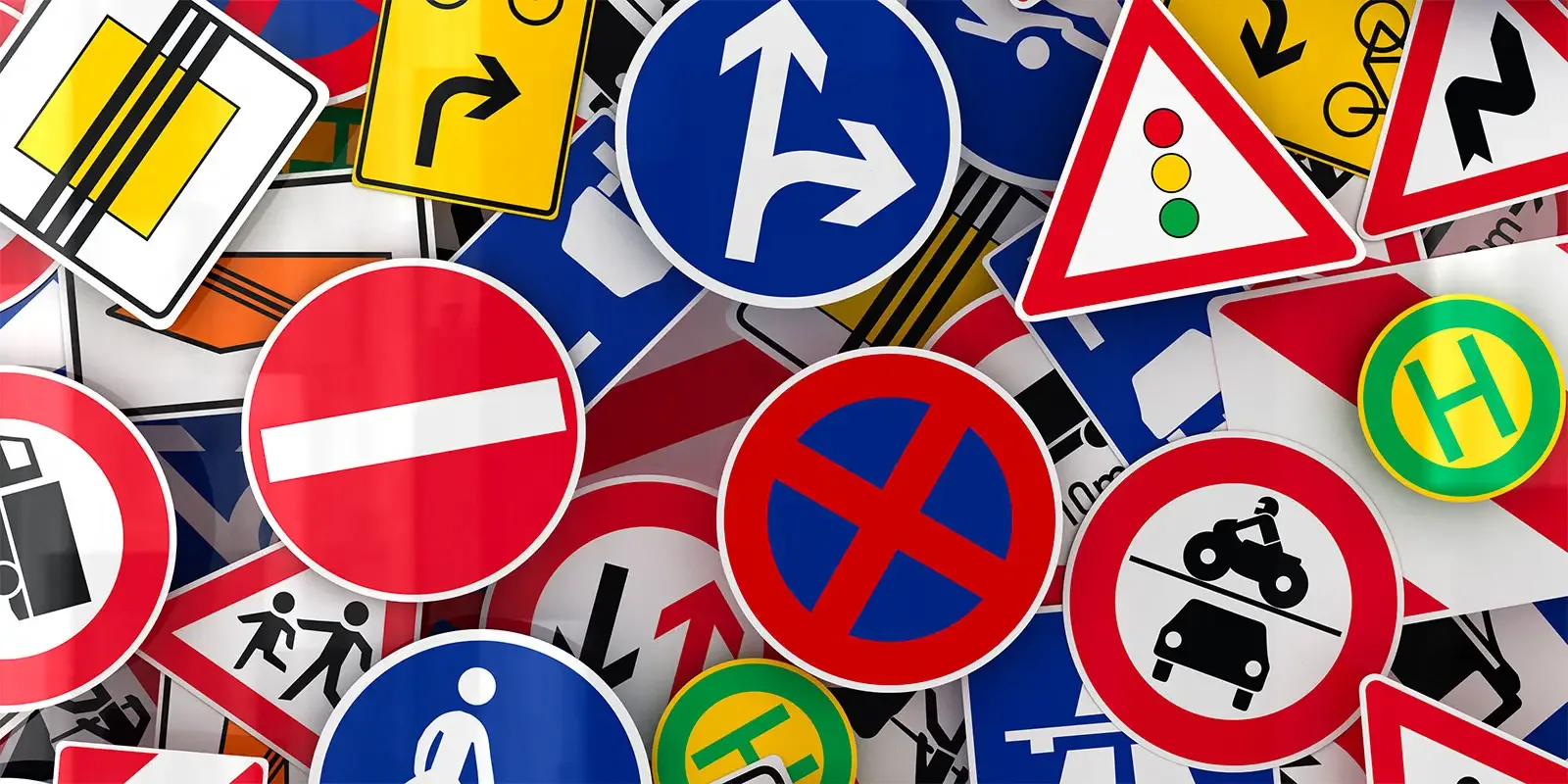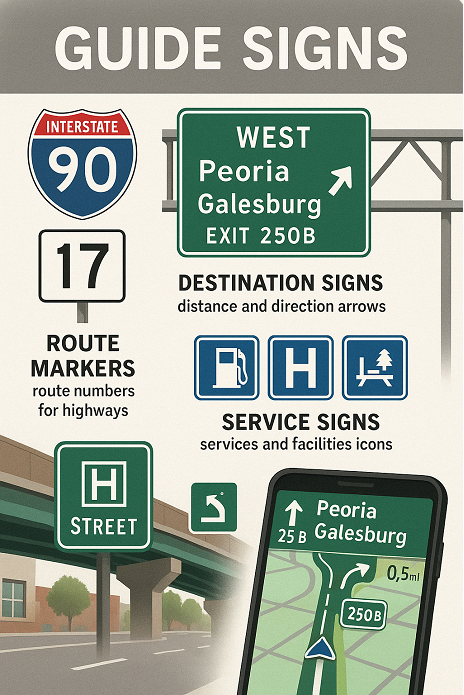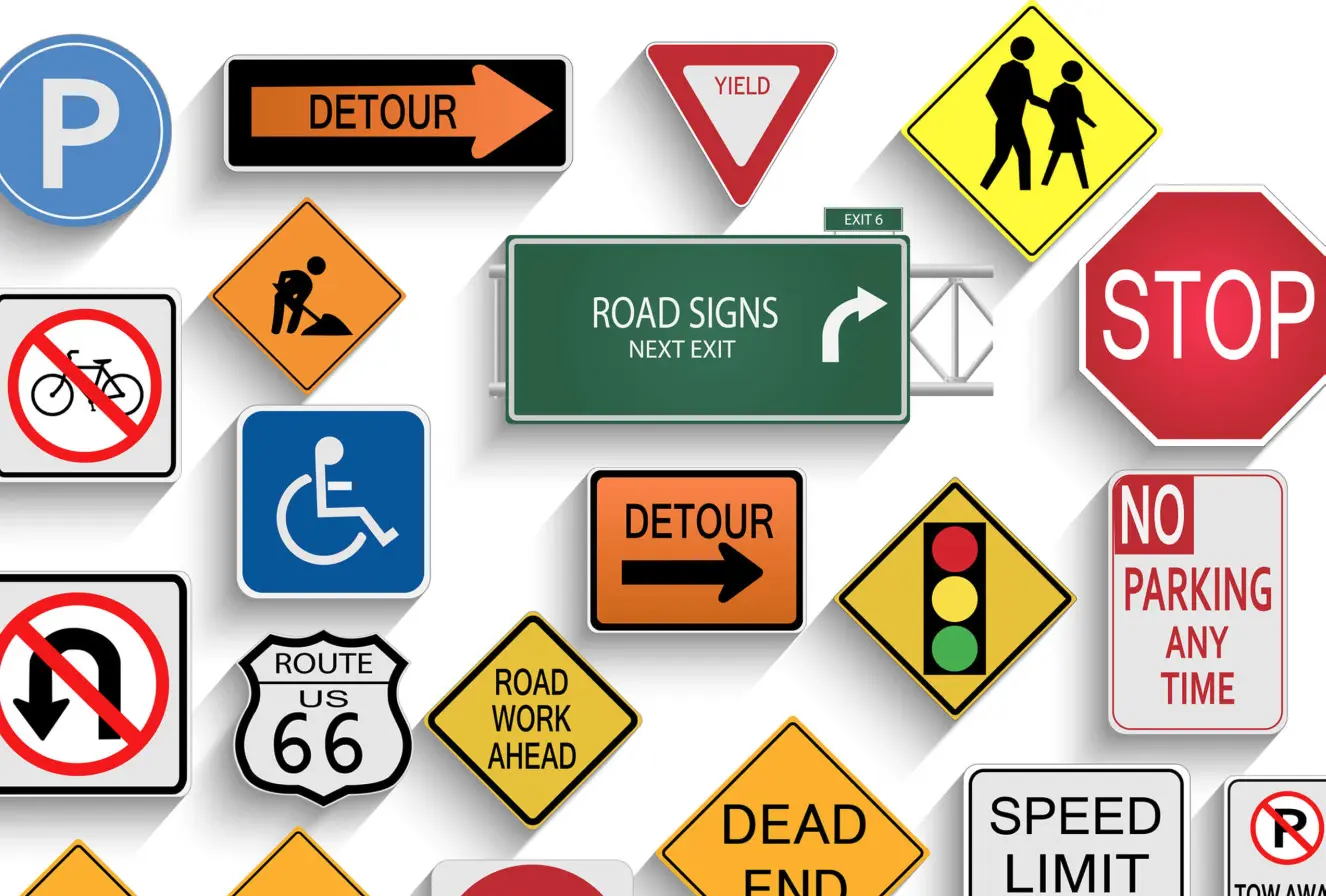
Guide signs are divided into several types based on the kind of information they provide. Each type serves a specific navigational function to assist drivers in reaching their destinations.
Route markers identify numbered highways and routes. These signs include symbols such as interstate shields, U.S. route signs, state highway markers, and county route indicators. They confirm that the driver is on a designated route and provide direction for continuity.
These markers often include arrows indicating direction changes and may be supplemented by additional signs showing route concurrency or alternate paths. Clear route marking is essential in rural and urban networks where multiple highways intersect.
Destination signs inform drivers of the names and distances to cities, towns, neighborhoods, and other destinations. These signs are typically placed in advance of interchanges or major intersections and include directional arrows.
The purpose of destination signs is to guide drivers through unfamiliar areas. By indicating the direction and distance to multiple locations, they assist in navigation and reduce last-minute lane changes or route confusion.


Service signs point to facilities that support traveler needs, such as gas stations, rest areas, hospitals, food, and lodging. These signs often use symbols for quick recognition and are placed near exits or along highways.
Service signs help drivers locate essential amenities, especially on long-distance routes. Their visibility and accuracy are important for planning stops and ensuring safe access to off-road services.
Effective guide signs rely on design features that enhance visibility and understanding. The goal is to convey information clearly, quickly, and without distracting the driver.
Legibility depends on font type, size, spacing, and contrast. Guide signs typically use large, reflective lettering with high contrast between text and background. Standard fonts, such as those specified in the Manual on Uniform Traffic Control Devices (MUTCD), are used to ensure consistency and promote uniformity of traffic devices across all road systems.
Letter height is based on roadway type and speed. For example, freeway signs use taller letters than urban streets due to the higher speeds and longer viewing distances. Proper legibility allows drivers to read signs in time to make decisions without abrupt movements, which supports safer navigation and reinforces consistent messaging.


Placement is critical to the effectiveness of guide signs. Signs must be located where drivers expect to see them, with enough distance to allow for decision-making and maneuvering. On multilane highways, overhead signs are used to reach all lanes, while ground-mounted signs may be suitable for smaller roads.
Engineers consider factors such as sight distance, traffic speed, and intersection complexity when positioning guide signs. In some cases, advance signs are placed well before the actual decision point to prepare drivers for upcoming changes.
As digital navigation tools become more common, the role of physical guide signs continues to evolve. Compatibility between signs and technology helps support consistent driver expectations and decision-making.
Digital navigation systems rely on up-to-date map data and accurate interpretation of physical signage. When guide sign messages are consistent with digital information, drivers can better align on-road cues with turn-by-turn directions.
Transportation agencies coordinate with mapping service providers to ensure changes to signage, routes, or exits are reflected in digital platforms. Mismatches between physical signs and GPS instructions can lead to confusion, missed turns, and unsafe maneuvers.
Guide signs also support redundancy. In cases where digital devices fail or lose connectivity, physical signage remains the primary navigation tool. For this reason, physical guide signs are designed to stand alone, independent of electronic aids.
Over time, guide signs have changed to reflect new transportation demands, design standards, and driver expectations. Early signs used simple lettering and limited symbols. As road systems expanded, signs adopted standardized shapes, colors, and fonts to enhance recognition and comprehension.


Advancements in materials have improved nighttime visibility. Retroreflective sheeting allows signs to be seen under low-light conditions without the need for illumination. Modular sign panels and computer-aided sign design tools have made it easier to update and produce consistent signage.
Some jurisdictions have experimented with dynamic guide signs that can change displayed information based on traffic conditions. These include real-time travel times to destinations, incident alerts, or temporary detours. Such signs bridge the gap between static guidance and live updates.
Guide signs play a direct role in shaping driver decisions. The timing, clarity, and relevance of the information affect how confidently and safely a driver navigates the roadway.
Unclear or poorly placed guide signs can lead to hesitation, sudden lane changes, or missed turns. In complex interchange areas or cities with multiple exits in close proximity, well-structured signage helps maintain traffic flow and reduces decision stress.
Guide signs also influence trip planning. When drivers are aware of upcoming services or destinations, they can plan stops in advance, reducing the likelihood of abrupt maneuvers or roadside searching. This contributes to smoother traffic patterns and reduced crash risks.


The primary purpose of guide signs is to provide information that supports navigation and trip planning. Route markers, destination signs, and service signs work together to direct traffic and assist drivers in reaching their destinations efficiently.
I provide attorneys and insurance adjusters in Mesa, AZ with the technical expertise they need in cases involving traffic accidents, roadway design, and traffic control.